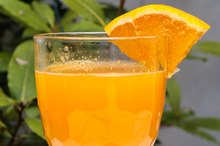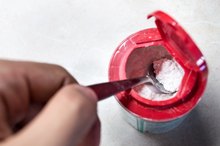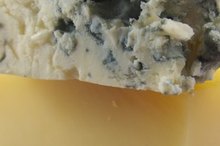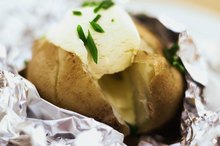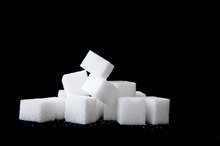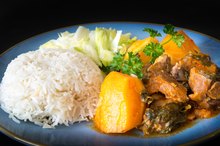Lactate & Lactose Intolerance
Despite the similar-sounding names, lactate and lactose aren't actually similar chemicals. Though both can occur in foods, including dairy products, they're not used by the same way in the body. Further, if you're lactose intolerant, that doesn't mean that you will have trouble processing lactate or eating lactate-containing foods.
If you are experiencing serious medical symptoms, seek emergency treatment immediately.
Lactate
Lactate is a negatively charged molecule formed from a compound called lactic acid. Some bacteria make lactate when they metabolize sugars. Humans also produce lactate as a byproduct of metabolism, though only under certain conditions. Specifically, says Dr. Gary Thibodeau in his book "Anatomy and Physiology," you make lactate when your cells process sugars for energy in the absence of oxygen, such as:
- when you're engaging in a hard sprint or power efforts during exercise [1](# 'inline-reference::“Anatomy
- Physiology”; Gary Thibodeau
- Ph.D.; 2007')
- Lactate is a negatively charged molecule formed from a compound called lactic acid.
- Humans also produce lactate as a byproduct of metabolism, though only under certain conditions.
Lactate in Food
Lactic Acid vs. Citric Acid
Learn More
Lactate can occur naturally in some foods, and in other cases, it's added. Fermented foods like sourdough bread and yogurt contain lactate naturally. This is because these foods are manufactured by allowing bacteria to convert a certain amount of the sugar in the dough or dairy into lactate, yielding a sour flavor and change in texture. Because lactate changes a food's acidity, it can make it hard for pathogenic bacteria to grow in the food. As such, lactate is sometimes added to foods as a preservative.
- Lactate can occur naturally in some foods, and in other cases, it's added.
- Because lactate changes a food's acidity, it can make it hard for pathogenic bacteria to grow in the food.
Lactose
Unlike lactate, lactose is a sugar. While it's possible for humans, other animals and bacteria to convert lactose to lactate through the process of fermentation, the chemicals have little in common. You take in lactose any time you consume milk or other dairy products. An enzyme called lactase, which occurs in your intestines, digests lactose into smaller molecules that you absorb into your bloodstream and can use for energy, say Drs. Reginald Garrett and Charles Grisham in their book "Biochemistry. 2"
- Unlike lactate, lactose is a sugar.
- An enzyme called lactase, which occurs in your intestines, digests lactose into smaller molecules that you absorb into your bloodstream and can use for energy, say Drs.
Lactose Intolerance
Lactose Monohydrate & Lactose Intolerance
Learn More
Some people don't produce enough lactase to digest lactose effectively. This is referred to as lactose intolerance. If you're lactose intolerant, consuming dairy causes you to experience a variety of uncomfortable gastrointestinal symptoms, including bloating and cramping. If you're lactose intolerant, you have to avoid lactose-containing foods. Alternately, you can take a lactase supplement when you consume dairy. You do not, however, need to avoid foods with natural or added lactate.
- Some people don't produce enough lactase to digest lactose effectively.
- If you're lactose intolerant, you have to avoid lactose-containing foods.
Related Articles
References
- “Anatomy and Physiology”; Gary Thibodeau, Ph.D.; 2007
- “Biochemistry”; Reginald Garrett, Ph.D. and Charles Grisham, Ph.D.; 2007
- Faude O, Kindermann W, Meyer T. Lactate threshold concepts: How valid are they?. Sports Med. 2009;39(6):469-90. doi:10.2165/00007256-200939060-00003
- Pennington C. The exercise effect on the anaerobic threshold in response to graded exercise. Int J Health Sci. 2015;3(1). doi:10.15640/ijhs.v3n1a14
- Aagaard P, Andersen JL. Effects of strength training on endurance capacity in top-level endurance athletes. Scand J Med Sci Sports. 2010;20 Suppl 2:39-47. doi:10.1111/j.1600-0838.2010.01197.x
- McGehee JC, Tanner CJ, Houmard JA. A comparison of methods for estimating the lactate threshold. J Strength Cond Res. 2005;19(3):553-8. doi:10.1519/15444.1
- Wilmore JH, Costill DL. Physiology of Sport and Exercise: 3rd Edition. Human Kinetics, 2005.
Writer Bio
Kirstin Hendrickson is a writer, teacher, coach, athlete and author of the textbook "Chemistry In The World." She's been teaching and writing about health, wellness and nutrition for more than 10 years. She has a Bachelor of Science in zoology, a Bachelor of Science in psychology, a Master of Science in chemistry and a doctoral degree in bioorganic chemistry.
